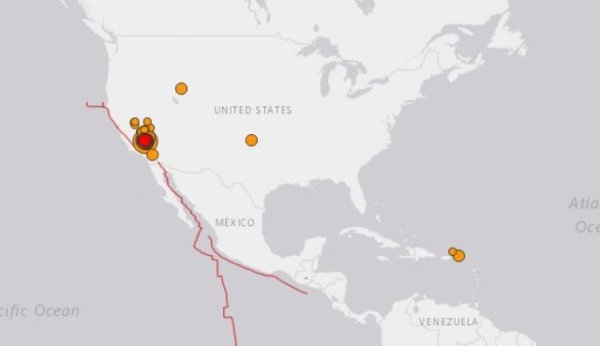
A “robust sequence” of earthquakes.
That quote above is from the eminent seismologist Dr. Lucy Jones. If you’ve watched the news about the earthquakes in California, you’ve seen her.
Here’s a quick report from our community in Southern California.
We’re in Orange County, along the coast in Southern California, about 160 miles from the earthquake epicenter at Ridgecrest, which is more in the center part of the state.
But even here, we felt both of the largest quakes – the 6.4 on July 4th, and the 7.1 yesterday on July 5th. No comparison – that second quake was MUCH bigger!
When it started, I was seated right here at my computer. The chair seemed to be moving left and right. Then it was definitely moving left and right! That died down, and then things started shaking. The whole house started bumping, rattling, creaking, clunking, blinds banging and banging against the windows! Happily, our lights stayed on. I moved away from the computer and monitor and my bookshelves, but nothing fell.
In the end, things gradually returned to normal. Today, the only damage I could find in my house were three new hairline cracks, perfectly aligned about 4 feet apart, from one side to the other of the tile kitchen floor.
Our neighborhood emergency response team got into action.
We are always preparing for earthquakes in California. Here in our community, several people quickly made phone calls, and we were also able to connect via email, but our main communications took place via walkie-talkies. Within about 5 minutes, neighbors were checking on neighbors and reporting in. Two of our team members monitored the news (using ham radio, too) and shared what they were learning. That info was passed along via the walkie-talkies. Within about 20 minutes, everyone had reported in to our “Command” channel: “People in the streets, no damage.”
What happened in Ridgecrest was far worse, and is a reminder about being prepared.
We should be prepared for any emergency with basic supplies:
- Sturdy shoes
- Flashlights and lanterns!
- First Aid kit
- Water
- Non-perishable food (in non-breakable containers)
- Blankets
In earthquake country, you want to stash these items throughout your house.
An earthquake isn’t like a storm, where you probably have some warning to grab your survival kit and head to shelter. In a quake you will still be at home afterwards, and so you want to be able to get to your supplies even if parts of the home are damaged.
And talk over a plan for contacting family members after an emergency. Be sure to include an out-of-area contact number.
Now, in my case, our out-of-state contact person, my brother – was somewhere on a boat headed to Alaska! So we need to set up a secondary contact right away.
What comes next?
We’ll be operating for a while based on what we learned last night about earthquakes in California. For us, the good news is our neighborhood volunteers were prepared and DID WHAT THEY HAD TRAINED TO DO.
If you are interested in building a neighborhood emergency response group, or strengthening the one you have, we have resources that can help! Check out our website: https://EmergencyPlanGuide.org! and if you have specific questions, please be in touch directly. We have some real experience — even more today than before — and we’d love to share.
Virginia
Your Emergency Plan Guide team
Day 6 of Summer Vacation: A time for some shorter and lighter Advisories as a welcome change-of-pace! (Or at least, that was the plan!)
Don't miss a single Advisory.
Thank you for subscribing.
Something went wrong.
